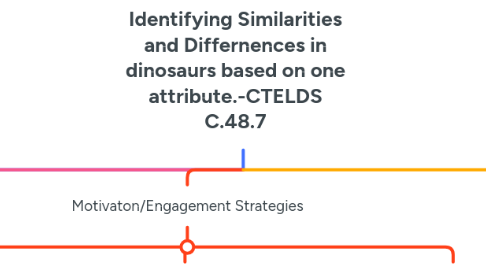
1. This supports students who learn from visuals and supports the executive functioning skills of working memory and organization
1.1. Reading the book "Bear Sees Colors"by Karma Wilson, use images from the book on popsicle sticks (Story props) and place them into colored toilet paper rolls consecutively as the story is read. This enables students to simultaneously see the sequence of the story as well as the sorting of objects by color.
2. Lesson Presentation
2.1. Visuals
2.1.1. Using visual story props while reading
2.2. Student Participation
2.2.1. Create opportunties for students to participate in the lesson
2.2.1.1. This supports the developmental age of a pre-k student in providing little time sitting still, as well as engages multisensory learning.
2.2.1.1.1. Cover tables in the room with colored table clothes. Provide students with multiple objects in various colors. Turn on a song about colors, and direct students to move around the rooms placing the items on the tables.
3. Student Comprehension Choices
3.1. Table time options for students to work at freely, and teachers to sit an engage/informally assess
3.1.1. Various tables are set up with multiple play-based opportunities to practice identifying similarities and differences in dinosaurs. Children will be asked to plan what table they'd like to visit first as well as what they would like to do thnd ere. This strengthens executive functioning by encouraging planning, time management, atask initation.
3.1.1.1. One table will be set up with a play-based table consisting of blocks, dinosaurs, and play mats. As the teacher visits this table, she will model how to play with the dinosaurs to encourage attribute identifying and sorting. ( i.e. Making a house for small dinosaurs and a house for big dinosaurs.)
3.1.1.2. Another table will have dinosaur stickers, markers, and crayons for students to illustrate how they identify and sort dinosaurs (i.e. draw an ocean and use dinosaurs with fins)
3.1.1.3. Another table will contain dinosaurs, measuring tape, and scales for students to measure and weigh dinosaurs and sort by lenght and weight.
3.1.1.4. Quiet center for students who prefer working and thinking in quiet where they can meet with a teacher and work on any of the tasks available in the quiet space.
4. Motivaton/Engagement Strategies
4.1. Monitor student prefernces and utilize a topic they are intereted in to obtain the goal. (Dinosaurs to teach attributes and sorting)
4.2. Utilize personal Connections. (What is your favorite dinosaur? What other dinosaurs are like it?)
4.2.1. Identify books, movies, and characters that relate to dinosaurs the children are familair with and utilize them in the activities and lessons to build background knowledge and engagement.
4.3. Gross motor games
4.3.1. This satisfies the CTELDS standard of using gross motor movements as well as provides motivation and engagement.
4.3.1.1. Rolling on belly boards to collect dinosaurs and sort them into categories.
